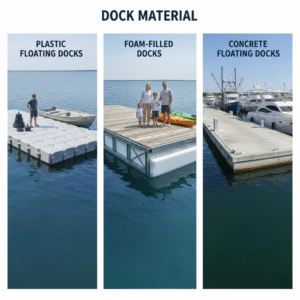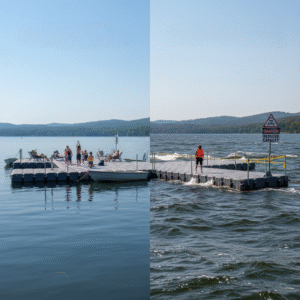How Much Weight Can a Floating Dock Hold? Complete Guide to Dock Capacity
How much weight can a floating dock hold is one of the most common questions asked by waterfront property owners, boaters, and marina operators. Floating docks are popular because of their flexibility, durability, and ease of installation. Whether you plan to use one for swimming, docking boats, or hosting gatherings by the water, understanding dock capacity is essential for both safety and performance.
In this complete guide, we’ll break down everything you need to know about floating dock weight capacity, factors that affect it, and tips to ensure your dock remains safe and reliable.
What Determines Floating Dock Weight Capacity?
The weight capacity of a floating dock depends on a few key factors:
- Dock Material
-
- Plastic floating docks: Made of high-density polyethylene (HDPE) or similar plastics, these docks typically hold 200–400 pounds per square foot depending on size and design.
- Foam-filled docks: These offer excellent buoyancy and can support 250–350 pounds per square foot.
- Concrete floating docks: Used in marinas and heavy-duty applications, they can hold 500+ pounds per square foot, making them ideal for large boats or commercial use.

- Dock Size and Design
Larger docks naturally have a higher overall capacity, but distribution matters. A narrow dock may support less weight per section than a wider, more stable one.

- Water Conditions
Calm lakes or ponds allow for higher usable capacity, while rough water, waves, or strong currents reduce safe limits.

- Load Distribution
Weight capacity isn’t just about the total number, it’s about balance. Concentrating too much weight on one corner can cause instability.

Average Weight Capacity of Floating Docks
To give you an idea, here’s a rough breakdown of typical floating dock capacities:
- Light-duty residential dock: 200–250 lbs per square foot
- Recreational/swimming dock: 250–350 lbs per square foot
- Commercial marina dock: 400–600 lbs per square foot
For example, a 10×10 ft residential floating dock (100 sq ft) rated at 250 lbs per sq ft could support about 25,000 pounds in total but that doesn’t mean you should stack that much weight on it. Safe capacity is usually lower to account for movement, water shifts, and uneven loading.
Why Weight Capacity Matters
Understanding your dock’s weight capacity is crucial for safety and longevity. Overloading a dock can cause:
- Instability – making it unsafe to walk or stand on
- Structural damage – bending, cracking, or breaking components
- Sinking or partial submersion – reducing buoyancy and lifespan
By staying within recommended weight limits, you ensure your dock lasts longer and stays safe for all activities.
Tips for Maximizing Floating Dock Capacity
- Choose the Right Type of Dock – If you plan to host large gatherings or dock bigger boats, consider heavy-duty or concrete floating docks.
- Distribute Weight Evenly – Spread people, furniture, and equipment across the dock rather than concentrating them in one spot.
- Check Manufacturer Specifications – Always review the specific capacity ratings from your dock manufacturer.
- Inspect Regularly – Look for signs of stress, such as sagging or uneven floating, and fix issues early.
- Add Extra Flotation – In some cases, additional float modules can be installed to increase buoyancy and capacity.
Final Thoughts
So, how much weight can a floating dock hold? The answer depends on the dock’s material, size, and design, but most residential docks support 200–350 pounds per square foot, while commercial docks can handle much more.
When choosing or building a floating dock, always consider how you plan to use it whether for swimming, fishing, docking boats, or entertaining guests. By understanding dock capacity and following safety best practices, you’ll enjoy years of reliable use. For high-quality floating docks built for durability and strength, trust Dockstop to deliver the best solutions for your waterfront needs.
